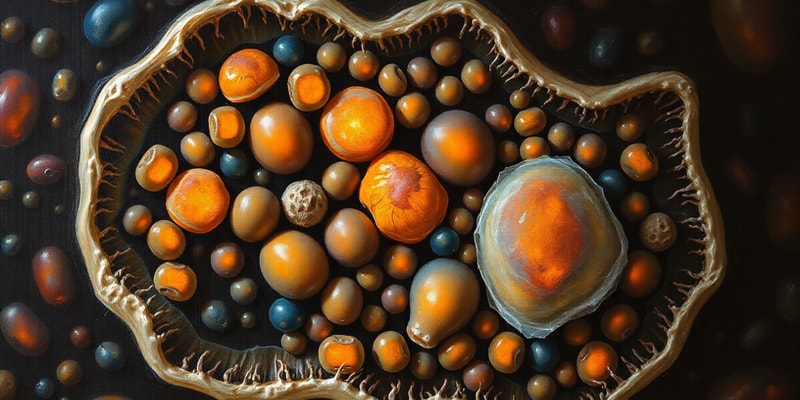Podcast
Questions and Answers
What is the primary function of the Krebs Cycle?
What is the primary function of the Krebs Cycle?
Where does beta oxidation of fatty acids occur?
Where does beta oxidation of fatty acids occur?
What is the role of cytochrome C in apoptosis?
What is the role of cytochrome C in apoptosis?
Which process involves converting ammonia into urea?
Which process involves converting ammonia into urea?
Signup and view all the answers
What differentiates mitochondrial ribosomes from cytoplasmic ribosomes?
What differentiates mitochondrial ribosomes from cytoplasmic ribosomes?
Signup and view all the answers
What is a primary precursor for gluconeogenesis?
What is a primary precursor for gluconeogenesis?
Signup and view all the answers
What is the primary function of ketogenesis?
What is the primary function of ketogenesis?
Signup and view all the answers
What is a key feature of mitochondrial DNA?
What is a key feature of mitochondrial DNA?
Signup and view all the answers
What is the main function of the electron transport chain in the mitochondria?
What is the main function of the electron transport chain in the mitochondria?
Signup and view all the answers
What is located in the intermembrane space of the mitochondria?
What is located in the intermembrane space of the mitochondria?
Signup and view all the answers
Which of the following describes the cristae in mitochondria?
Which of the following describes the cristae in mitochondria?
Signup and view all the answers
Which process occurs in the mitochondrial matrix?
Which process occurs in the mitochondrial matrix?
Signup and view all the answers
What role do NADH and FADH2 play in mitochondrial function?
What role do NADH and FADH2 play in mitochondrial function?
Signup and view all the answers
What is the primary molecule produced from the conversion of pyruvate in the mitochondrial matrix?
What is the primary molecule produced from the conversion of pyruvate in the mitochondrial matrix?
Signup and view all the answers
Which statement is true regarding mitochondrial DNA (mtDNA)?
Which statement is true regarding mitochondrial DNA (mtDNA)?
Signup and view all the answers
What happens during the process of proton pumping in mitochondria?
What happens during the process of proton pumping in mitochondria?
Signup and view all the answers
Study Notes
Mitochondria Structure:
- Sausage-shaped organelle: found in both plant and animal cells.
- Double membrane: Consists of an outer membrane, which is highly permeable, and an inner membrane, which is less permeable.
- Intermembrane space: The space between the outer and inner membranes, rich in proton ions.
- Cristae: Invaginations of the inner membrane that increase surface area for metabolic reactions.
- Mitochondrial matrix: The fluid-filled interior of the mitochondria, containing mitochondrial DNA (mtDNA) and ribosomes.
Mitochondria Functions:
- Protein transport: The mitochondria import proteins from the cytoplasm, which are then folded and activated in the mitochondrial matrix.
- Miscellaneous transport: The mitochondrial membranes allow the transport of various small molecules, including carbohydrates, fatty acids, and amino acids, needed for metabolic reactions.
-
Electron transport chain: Occurs on the inner membrane and is responsible for ATP production via oxidative phosphorylation.
- Electron carriers: NADH and FADH2 carry electrons from metabolic reactions to the electron transport chain.
- Proton pumping: The movement of electrons along the chain pumps protons into the intermembrane space, creating a proton gradient.
- ATP synthesis: The proton gradient drives ATP synthesis by ATP synthase.
- Reactive oxygen species (ROS) production: A side effect of the electron transport chain, which can damage cells.
Mitochondrial Matrix Functions:
-
Metabolic reactions: The matrix houses various enzymes involved in metabolic pathways, including:
- Krebs cycle: Generates ATP, NADH, and FADH2.
- Fatty acid oxidation (beta-oxidation): breaks down fatty acids into acetyl-CoA.
- Amino acid metabolism: processes amino acids for energy or biosynthesis.
- Mitochondrial DNA (mtDNA): Codes for a small number of proteins necessary for mitochondrial function and is maternally inherited.
- Ribosomes: Used for protein synthesis within the mitochondria.
Mitochondrial Matrix Functions
- Pyruvate to Acetyl-CoA conversion: This is the initial step in the process of breaking down glucose, the primary fuel source for cells. It involves transforming pyruvate, a product of glycolysis, into Acetyl-CoA, a key molecule for energy production.
- Krebs Cycle: Also known as the citric acid cycle, this is a series of chemical reactions that occur in the mitochondrial matrix, producing high-energy molecules like NADH and FADH2. These molecules are then used in the electron transport chain to generate ATP, the main energy currency of cells.
- Beta Oxidation of Fatty Acids: Fatty acids, long chains of carbon atoms, are broken down into Acetyl-CoA through a process known as beta oxidation. This process occurs in the mitochondrial matrix and is another source of energy for cells.
- Urea Cycle: This cycle is responsible for converting toxic ammonia, a byproduct of amino acid metabolism, into the less toxic urea. The urea cycle takes place both in the mitochondrial matrix and cytoplasm.
- Gluconeogenesis: The synthesis of glucose from non-carbohydrate precursors like amino acids and odd-chain fatty acids. This vital process occurs in both the mitochondrial matrix and cytoplasm, ensuring glucose availability when dietary intake is insufficient.
- Heme Synthesis: This process involves the production of heme, a molecule essential for hemoglobin and other proteins. Heme synthesis partially occurs in the mitochondrial matrix and the cytoplasm.
- Ketogenesis: Acetyl-CoA can be converted into ketone bodies, alternative fuel sources for the brain and other tissues when glucose is limited. This process occurs in the mitochondrial matrix.
Mitochondrial DNA and Ribosomes
- Mitochondrial DNA (mtDNA): Unlike nuclear DNA, mtDNA is circular and encodes for proteins essential for mitochondrial function. It can undergo replication, allowing the mitochondria to divide and generate new mitochondria.
- Mitochondrial Ribosomes: These ribosomes are unique to the mitochondria and are responsible for protein synthesis. They are distinct from the cytoplasmic ribosomes in eukaryotic cells and are referred to as 70S ribosomes.
Apoptosis
- Cytochrome C: This molecule is normally present in the mitochondrial matrix and plays a vital role in cellular respiration. However, during apoptosis or programmed cell death, cytochrome C leaks out of the mitochondria, triggering a cascade of events leading to cell death.
- Caspases: These enzymes are activated by cytochrome C and are responsible for breaking down cellular components and ultimately causing cell death.
Endosymbiotic Theory:
- This theory proposes that mitochondria originated from symbiotic bacteria that were engulfed by early eukaryotic cells. This led to the mitochondria becoming integrated into the eukaryotic cell, providing energy and other functions.
Mitochondria Structure
- Sausage-shaped organelle found in plant and animal cells with a double membrane.
- The outer membrane is highly permeable while the inner membrane is less permeable.
- The space between the outer and inner membranes is called the intermembrane space, which is rich in protons.
- The inner membrane folds into cristae, increasing the surface area for metabolic reactions.
- The mitochondrial matrix is the fluid-filled interior containing mitochondrial DNA (mtDNA) and ribosomes.
Mitochondria Functions
- Mitochondria import proteins from the cytoplasm for folding and activation in the mitochondrial matrix.
- Mitochondrial membranes transport carbohydrates, fatty acids, and amino acids needed for metabolic reactions.
- The electron transport chain is responsible for ATP production through oxidative phosphorylation and takes place on the inner membrane.
- NADH and FADH2 carry electrons from metabolic reactions to the electron transport chain.
- The movement of electrons along the chain pumps protons into the intermembrane space, creating a proton gradient.
- This proton gradient drives ATP synthesis by ATP synthase.
- The electron transport chain also produces reactive oxygen species (ROS) which can damage cells.
Mitochondrial Matrix Functions
- The matrix contains enzymes involved in various metabolic pathways.
- This includes the Krebs cycle for generating ATP, NADH, and FADH2.
- It also involves fatty acid oxidation (beta-oxidation) for breaking down fatty acids into acetyl-CoA.
- The matrix processes amino acids for energy or biosynthesis.
- The matrix contains mtDNA, which codes for proteins necessary for mitochondrial function and is maternally inherited.
- The matrix also houses ribosomes for protein synthesis within the mitochondria.
Pyruvate to Acetyl-CoA Conversion
- This is the initial step in breaking down glucose.
- Pyruvate, a product of glycolysis, is transformed into Acetyl-CoA, a key molecule for energy production.
Krebs Cycle
- This cycle of chemical reactions occurs in the mitochondrial matrix.
- It produces high-energy molecules like NADH and FADH2.
- These molecules are used in the electron transport chain to generate ATP.
Beta Oxidation of Fatty Acids
- This process breaks down fatty acids into Acetyl-CoA.
- It occurs in the mitochondrial matrix and is another source of energy for cells.
Urea Cycle
- This cycle eliminates toxic ammonia as urea.
- It takes place in both the mitochondrial matrix and cytoplasm.
Gluconeogenesis
- This process synthesizes glucose from non-carbohydrate precursors.
- It occurs in both the mitochondrial matrix and cytoplasm.
Heme Synthesis
- The production of heme, essential for hemoglobin and other proteins.
- It partially occurs in the mitochondrial matrix and cytoplasm.
Ketogenesis
- Acetyl-CoA can be converted into ketone bodies.
- These are alternative fuel sources when glucose is limited.
- This process occurs in the mitochondrial matrix.
Mitochondrial DNA and Ribosomes
- mtDNA is circular and encodes for proteins essential for mitochondrial function.
- mtDNA can replicate, allowing the mitochondria to divide and generate new mitochondria.
- Mitochondrial ribosomes are unique to the mitochondria and responsible for protein synthesis.
- They are distinct from cytoplasmic ribosomes and are referred to as 70S ribosomes.
Apoptosis
- Cytochrome C is normally present in the mitochondrial matrix but leaks out during apoptosis.
- This triggers a cascade of events leading to cell death.
- Caspases are activated by cytochrome C and break down cellular components, ultimately causing cell death.
Endosymbiotic Theory
- This theory suggests mitochondria originated from symbiotic bacteria engulfed by early eukaryotic cells.
- This integration led to mitochondria providing energy and other functions to the eukaryotic cell.
Studying That Suits You
Use AI to generate personalized quizzes and flashcards to suit your learning preferences.
Description
Test your knowledge about the structure and function of mitochondria in this quiz. Explore their roles in cellular processes and understand the significance of their unique anatomy. Perfect for biology students looking to reinforce their understanding of this essential organelle.



